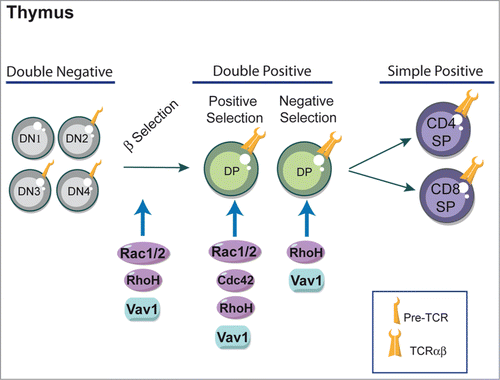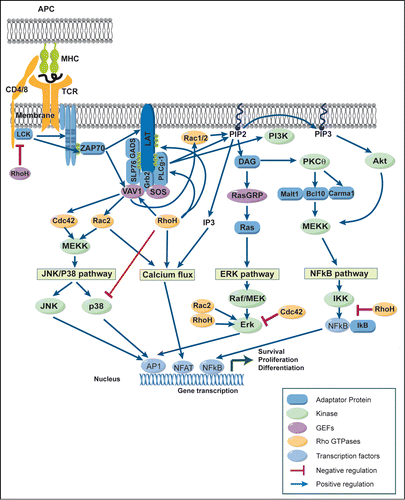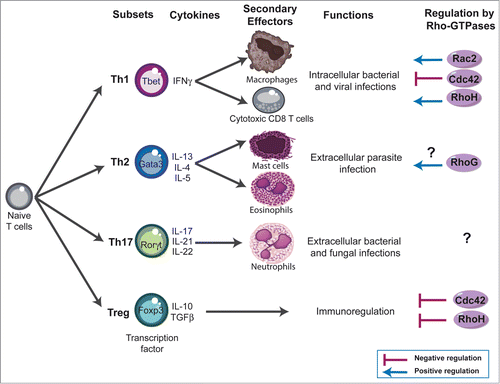Figures & data
Figure 1. Rho-GTPases and thymic development of T cells. Differentiation of T cells occurs within the thymus. Most T cells develop along 3 steps: CD4− CD8− double negative (DN), CD4+ CD8+ double positive (DP) and mature CD4+ or CD8+ single positive (SP) stages. Key regulatory signals are mediated through both the pre-TCR and TCR complexes. Signals from the pre-TCR allow cells to differentiate into DP cells and proliferate (β-selection). DP T cells rearrange their TCR and undergo further maturation process that leads to positive selection or nedative selection depenting to TCR binding avidity. DP cells with a MHC class I-restricted TCR differentiate into CD8+ SP T cells, whereas MHC class II-restricted cells are directed into CD4+ SP T cells. The Rho-GTPases shown to influence thymic selection using Rho-GTPases-deficient mice are indicated in the figure and discussed in more detail in the text.

Figure 2. Rho-GTPases regulate signaling pathways induced after TCR engagement. Schematic view of the signaling events induced in mature T cells after the recognition of an antigen presenting cell (APC) expressing peptide-MHC complexes. Binding of the T-cell receptor (TCR) to its ligand leads to a complex cascade of biochemical events that initiate distinct signaling pathways including (1) the Mitogen Activated Protein Kinase (MAPK) pathway including extracellular signal–regulated kinase (ERK), c-Jun NH2-terminal kinase (JNK) and p38, (2) the Ca/calcineurin/NFAT pathway, and (3) the NF-κB pathway. Eventually, these signaling pathways result in the activation of transcription factors like AP-1, NFAT, and NF-κB, which control the gene expression program characteristic of activated T cells. Rho-GTPases regulate positively (blue arrows) or negatively (red lines) these TCR signaling pathways. For more details, see text.

Figure 3. Rho-GTPases influence - lymphocyte differentiation. Four major subsets of CD4 T cells have been defined; T helper (Th) 1, Th2, Th17, and regulatory T cells (Treg). These subsets exert their immune functions through secretion of distinct patterns of cytokines and activation of different effector cells: Th1 mediate clearance of intracellular pathogens by producing IFN-γ and by activating macrophages and cytotoxic effector CD8 T cells. Th2 cells are involved in the elimination of parasitic organisms by secreting IL-4, IL-5, and IL-13 and by activating basophils and eosinophils. Th17 cells are involved in the clearance of intracellular pathogens by producing IL-17 and activating neutrophils. Similar subsets have been also described within CD8 T cells compartment (not shown). Foxp3 Treg play a crucial role in downregulating immune responses by suppressing several actors of the immune responses. The Rho-GTPases shown to influence - cell differentiation using deficient mice are indicated in the figure and discussed in more detail in the text.

